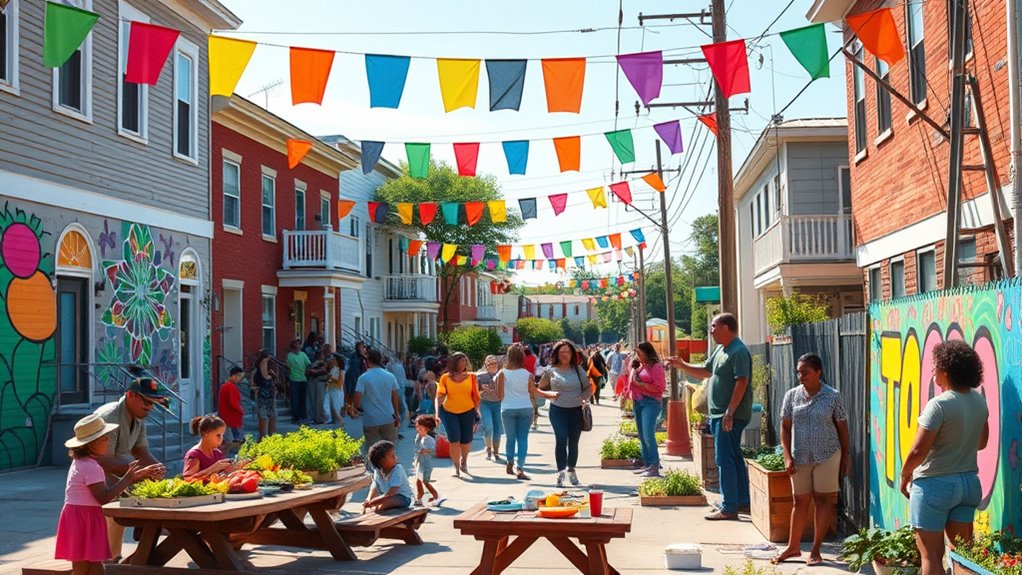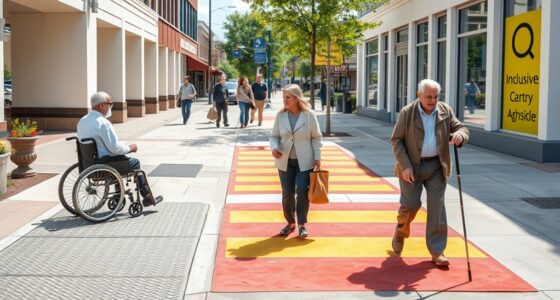To strengthen social bonds in your neighborhood, focus on creating inviting shared spaces like parks and community gardens where residents naturally gather. Organize local events, such as block parties or clean-up days, to boost participation and build relationships. Guarantee spaces are inclusive and accessible, welcoming everyone regardless of age or background. By fostering collaboration and pride in your community, you’ll turn your neighborhood into a vibrant and supportive environment—exploring these ideas further can help you make a real difference.
Key Takeaways
- Shared spaces like parks and community gardens foster natural interactions, building trust and strengthening social bonds among residents.
- Organizing community events such as block parties and clean-up days encourages active participation and relationship building.
- Ensuring shared spaces are accessible and inclusive promotes diverse involvement and a sense of belonging for all community members.
- Resident-led planning and decision-making align spaces with local needs, increasing engagement and community ownership.
- Investing in local engagement initiatives enhances cooperation, mutual support, and sustainability within neighborhoods.

Have you ever wondered what makes a neighborhood truly thrive? It’s often the strength of the social bonds you build within it. When residents actively participate in local engagement, the community becomes more than just a collection of houses—it transforms into a vibrant, supportive environment. Local engagement involves your participation in neighborhood events, volunteering, or simply chatting with neighbors. These interactions foster a sense of belonging and trust, which are essential for a thriving community. Shared spaces play a vital role in this process because they serve as the heart of social interaction. Think parks, community gardens, or local cafes—places where you can connect naturally with others. When shared spaces are well-maintained and welcoming, they encourage residents to gather, share ideas, and collaborate on projects that benefit everyone.
Creating opportunities for local engagement isn’t just about organizing events; it’s about making it easy and inviting for everyone to get involved. For instance, community-led activities like block parties, clean-up days, or local markets can turn passive residents into active participants. These gatherings provide a platform for neighbors to meet, share stories, and build relationships. When you see familiar faces in shared spaces, it creates a sense of familiarity and safety that encourages ongoing participation. It’s also important to guarantee these spaces are accessible and inclusive, welcoming people of all ages, backgrounds, and abilities. This openness helps to break down barriers and foster a diverse, cohesive community.
In addition, shared spaces should reflect the needs and interests of the neighborhood. This could mean designing parks with sports facilities, creating community gardens for urban agriculture, or setting up cozy seating areas for casual conversations. When residents feel a sense of ownership and pride in these spaces, they’re more likely to use and maintain them. Engaging residents in planning and decision-making ensures shared spaces truly serve the community’s needs, strengthening social bonds even further. The more you invest in local engagement and shared spaces, the more your neighborhood develops a spirit of cooperation and mutual support. This interconnectedness makes your community resilient, welcoming, and a place where everyone feels they belong. Ultimately, thriving neighborhoods aren’t just about infrastructure—they’re about the people who come together to nurture and sustain them.
Additionally, understanding the importance of environmental considerations like sustainable practices and low-impact camping can help communities promote eco-friendly development and outdoor activities that preserve natural beauty for future generations.
Frequently Asked Questions
How Can New Residents Quickly Integrate Into the Community?
To quickly integrate into your new community, focus on engaging actively with neighbors and participating in local events. Seek out opportunities for cultural integration, like festivals or community projects, to feel more connected. Consider joining a neighborhood mentorship program, where experienced residents can offer guidance and introduce you to others. Building genuine relationships through these efforts helps you feel welcomed and establishes a strong sense of belonging in your new environment.
What Are Effective Ways to Resolve Neighborhood Conflicts Peacefully?
Imagine conflicts as tangled threads that, with patience, can be woven into harmony. You can resolve neighborhood conflicts peacefully by practicing mediation techniques, where you listen actively and encourage open dialogue. Focus on conflict resolution by understanding each person’s perspective and finding common ground. Staying calm and respectful helps untangle disagreements, transforming chaos into cooperation. Your proactive approach fosters trust and strengthens community bonds, turning conflicts into opportunities for connection.
How Do Community Events Foster Long-Term Social Bonds?
Community events like block parties and volunteer programs play a key role in fostering long-term social bonds. When you participate in block parties, you get to meet neighbors, share experiences, and build trust. Volunteer programs encourage teamwork and a sense of shared purpose. As you engage consistently, these events help you create meaningful connections, making your neighborhood feel more connected, supportive, and resilient over time.
What Role Do Local Leaders Play in Strengthening Neighborhoods?
Local leaders play a crucial role in strengthening neighborhoods by fostering leadership development and encouraging civic collaboration. You can rely on them to connect residents, address community needs, and promote shared goals. They inspire trust, facilitate communication, and mobilize resources, creating a united environment. Their active involvement motivates residents to participate in local initiatives, ultimately building stronger, more resilient neighborhoods where social bonds thrive and everyone feels valued.
How Can Technology Enhance Community Engagement and Participation?
Technology can substantially boost community engagement and participation by leveraging digital platforms and virtual town halls. You can use these tools to connect with neighbors, share information, and organize events more easily. Virtual town halls allow you to voice concerns and stay informed, even if you can’t attend in person. By embracing these digital solutions, you create a more inclusive and active neighborhood where everyone feels heard and involved.
Conclusion
As you see how community-centered neighborhoods build stronger bonds, you realize the true power lies in connection. But what if the next step is just around the corner? The future of these neighborhoods depends on your actions—will you help foster trust, support, and unity? The potential is immense, and the coming changes could redefine how we live together. Are you ready to be part of this transformative journey? The next chapter is waiting to be written, and it starts with you.









